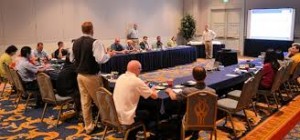The Intervention Phase
Top-down change management creates the problem of resistance with leaders battling to motivate and engage. OD supports organizational change by utilizing their people resource. Rather than creating barriers and a culture of fear, OD intervention methods should be designed to enable people to speak up.

Once the Diagnostic Phase has been completed, the feedback report should provide the information needed to design a robust action plan for OD interventions that will enable the organization to continue its change journey. By this point the disturbance process should be in full effect and options for OD techniques and methodologies can drive real behavior change as well as change to structure, process, and policy. Interventions can be devised to address a number of organization system requirements sustaining and maintaining some elements, consolidat- ing progress made, building on strengths, or preparing for future changes. Interventions can be limited to examining a single issue or an ongoing program of interventions designed for progressive development. At the core of each OD intervention is the search for existing organizational capacity, which can help progress the organization toward prospective futures.
Based on the theoretical underpinning of OD practice, there are a number of OD tools and techniques available to the OD practitioner. Key questions to be addressed during that the Intervention Phase are:
■ Where and at what level within the organization should the intervention be deployed?
■ What specific areas of change are required and to whom: individuals, teams, functions, or the whole organization?
■ What is the focus of the intervention: task, process, or people?
■ Given the organization culture should interventions be rigorously planned or will the change journey be emergent?
■ What intervention tools and techniques best t the organizational environment and have the potential to deliver the outcome required?
■ Who within the organization will be in- volved in codesigning interventions alongside the OD practitioner?
■ What actions can the OD practitioner take to improve the client’s ability to deal with future problems?
An Intervention Model—Harnessing the Human Resource
OD interventions should engage with the tripartite of thinking, feeling, and being, which is central to human endeavor. Harnessing the Human Resource within the organization requires that each intervention engages with rational logic, awareness and self-awareness, and transpersonal elements of the change process.
Reasoning
OD creates space for individuals to think using iterative methods of action and re- ection. It grants access to the full range of intellectual capacity and knowledge depositories within the organizational boundary allowing for a high-level interchange of ideas and information. Reasoning creates an arena, which allows individuals to utilize the intellectual capacity available within the organization, resulting in solutions that are broader in scope, thought through, innovative, and creative.
Observance
The links to behavioral science mean that OD interventions encourage people to watch, notice, perceive, and observe their own behavior and that of others within the organization. Sometimes referred to as emotional intelligence, the act of increasing awareness into how people behave and exploring why they behave in that way in- creases an observance of behavior, which, once noticed, can be developed.
Appreciation
OD engages with individuals to appreciate their own, and others’, feelings, values, and beliefs. This appreciation transcends the requirement to be right, and instead develops a connection even in difference. Clear perception and recognition of how individuals activate their beliefs and values results in greater levels of understanding and appreciation, which enables personal peak performance.
The OD Tool Kit—What you Need for the Intervention Phase
The intervention phase is the beating heart of the OD program and harnesses the human resource in the organization to create a safe environment where ideation, creativity, and innovation are utilized to overcome challenges and pursue opportunities. The techniques and methods required for the intervention phase of the OD cycle are:
- Acknowledgment of complexity
- Cultural sensitivity
- Knowledge and methods relating to adult learning and learning through play
- Knowledge and skills in employing OD Methods, for example:
- Community Learning (Fulton, 2005)
- World Café (Brown and Issacs, 2007)
- Open Space Technology (Owen, 2008)
- Charrettes (Lennertz, 2003)
- Theory U (Scharmer, 2009)
- Work-Out (Ulrich et al, 2002)
- Sustained Dialogue (Saunders, 2012)
- Ability to develop supportive and safe environments
- Flexibility and adaptability to respond to the ow and messiness of the intervention environment
Summary
■ OD supports organizational change by utilizing the people resource.
■ The feedback report from the Diagnostic Phase should provide the information needed to design a robust action plan for OD interventions.
■ At the core of each OD intervention is the search for existing organizational capacity, which can help progress the organization toward prospective futures.
■ Harnessing the Human Resource within the organization requires that each intervention utilizes reasoning, observance, and appreciation.
Focused conversations – Introducing a New Topic
If you are introducing a group to a new topic, whether in a training session or in an OD workshop where you what to open them up to new ideas and also get them to realise that they probably have some of the knowledge they need already – try this focused conversation.
Opening
Well Today we’re going to launch into a new topic – [NAME TOPIC] Let’s talk about this a bit. We all have some experience of this area.
Objective Questions
- When was your first experience of this topic?
- As you think about this, what images jump into your mind?
- What are some of the things we already know about this?
Reflective Questions
- What feelings do you associate with this topic?
- What are some of your past experiences related to the topic?
- What colour do you associate with this?
- What animal does it remind you of?
- What aspects of it do you enjoy?
- What don’t you like about it?
- What is the most challenging things about it?
Interpretative Questions
- Why is this topic important?
- How will if affect you? Your work? Other aspects of your life?
- What are your major questions in this area?
Decisional Questions
- How can we help each other learn about this topic?
Closing
As we share our insights like this, we have already taken the first steps in grasping this topic.
Organizational Psychology – Team Structure
Answers the Question
What the pros and cons of the four types of interdependence in teams?
How it Began
Individuals have their own identity, but they are interdependent when working within a team, which means that the team itself is has a holistic identity of its own, this creates a ‘ground paradox’. Weick, 1976 developed the concept of loosely structure systems which has lead to literature exploring the operationalization of four specific dimensions of structural interdependence a) Task Allocation Structure b) Decision Making Structure c) Reward Structure d) Communication Structure.
Key Terminology
- Interdependence – A dependence on 2 or more people, things, events or entities on each other.
- Team Structure – Organized individuals that constitute unity, composed of correlated elements
- Decision Making – Deciding between alternatives.
In Brief
Task Allocation Structure (Horizontal interdependence)
Where task allocation structures are team based often where jobs are complex and have fairly high levels of autonomy, high level of cognitive ability are needed. In these situations Ellis et al (2004) discovered that decentralized team members who have authority to make individual decisions, increase their ease of learning and adapting, are more innovative and is conducive to demands for speed or learning. In functional structures, where roles are fragmented and there are high levels of interdependence, coordination becomes very important which is supported by team members with an agreeable personality trait. Ellis et al (2004) found that a designated leader with a degree of authority is required in these situations to ensure coordination. Where the organizational structure is misaligned high levels of stress or conflict may occur increasing the need for emotional stability.
Decision-Making Structure (Vertical Interdependence)
Jundt et al, (2004) found structural contingencies on both horizontal and vertical dimensions impact team performance and the costs and benefits of both type of structure are similar. They concluded that Horizontal and vertical structures compliment each other.
Reward Structure (Outcome Interdependence)
Bamberger and Levi (2009) investigated reward structure based on norms of equity, equality or some combination of the two and incentive intensity. Their findings indicated that relative to equity-oriented group-based pay structures, equality-oriented pay structures are found to result in both significantly more help giving in general by team members and the type of help being offered leading to a higher likelihood of enhanced group-level competencies (i.e. autonomous help). Incentive intensity strengthens the effects of reward allocation on the amount (but not the type) of help giving within teams. Rosenbaum et al (1980) demonstrated that even a modicum of competitive reward led to lowered efficiency and productivity.
Beersma et al (2003) concluded that in regards to a teams external fit, competitive reward structures enhance speed but decrease accuracy whereas cooperative reward structures enhance accuracy and decrease speed. In regards to internal fit extroverted and agreeable people are best suited for cooperative reward structures whereas introverted and disagreeable people are best suited for competitive reward structures.
Communication Structure (Spatial Interdependence)
The set of individual differences that predict team performance in a changing situation may be quite distinct from those that predict performance in more routine situations therefore the effective team composition is required if the team is likely to experience unexpected change.
What does this mean for Organisational Development?
To achieve its objectives, an organisation needs to operate within a structure best suited to its purposes. Traditionally large businesses divide the organisation up into functional areas, with a hierarchical top down power structure. However, depending on the type of organisation and the interdependencies required within teams, as well as the personalities of the team members the traditional pyramid structure may not be suitable for effective performance.
For innovative, fast moving organizations and those which often deliver products and services via project teams bought together for that purpose, a more flexible matrix organizational structure is more suitable.
Some organizations have gone further in their pursuit of collaborative ‘soulful’ organizational structures, with remarkable results. Laloux in his book argues that the way organizations are managed is increasingly out of date and more enlightened organizational structures and practices are needed.
Organisational Psychology – Person-Environment Fit in Organizational Settings
Answers the Question
How do individuals simultaneously desire to fit in terms of being similar to others and be distinctive from others?
How it Began
Person-Environment fit has been a subject of increased interest over the past two decades. Understanding how the relationship between people and their work environment and the impact that the ‘fit’ between the two elements have on performance, satisfaction, adjustment, turnover, effective team work, creativity and innovation is essential to competitive advantage. Person-Environment fit is as old as rational thought. Plato emphasized the importance of matching people to jobs that aligned with their temperament and ability. In the 1900s theories around congruence began to be developed. In 1909 Parsons introduced fit in regards to matching individual attributes to those of different vocations. Person-Environment fit foundational theories stem from Murray’s need-press model and interactionism (1938)
Throughout the 1950s additional models appeared such as needs-supply theory, psychological stress and strain and Ability-Demand Theories. By the 1960s theories regarding adjustment, and the dynamism of processes involved in Person-Environment Fit were introduced by Dawis & Lofquist (1964).
Since that time the concept of fit is a foundation stone of most organizational research. Selection and assessment, performance management, Learning and Development, Career management, Leadership, organizational culture, attrition, diversity and stress all use a fit perspective to research behaviour and performance.
Key Terminology
Fulfillment – Individuals needs or values are fulfilled, or individuals’ abilities meet or fulfil the environmental job demands. Getting what one wants.
Interactionism – The interplay between characteristics of the person and situational factors namely in the form of match or congruence.
Similarity – Congruence between the characteristics of people and the corresponding characteristics of the environment. Being in accord.
Compilation – Attributes that differ but support and reinforce one another. Combination of related but distinct characteristics.
In Brief
Person–environment fit theory offers a framework which enables an organisation to assess and predict how characteristics of the individual employee and the organisational work environment determine, jointly, employee engagement, performance and well-being. In understanding the characteristics which are identified as relevant a model for developing interventions to prevent misalignment and/or increase fit.
Person Environment fit can be viewed from the following perspectives;
- Employee’s needs – needs–supplies fit
- Job–environment’s demands – demands–abilities fit
The term needs–supplies fit refers to the degree to which the needs of the individual employee, such as the need to use their skills and abilities, are supplied by the work environment and opportunities are available to satisfy the needs of the individual.
Demands–abilities fit refers to the degree to which the job’s demands are met by the employee’s skills and abilities. These two types of fit can overlap. For example, poor work-life balance may leave the organisation’s job role demands unmet as well as damage the individual employee’s need to be able to satisfy others.
A variety of different approaches to the measurement of Person Environment fit enhance the model’s potential for predicting well-being and performance. For example, Edwards and Harrison (1993)used statistical modelling to demonstrate that Person Environment fit explained about 6% more variance in job satisfaction than was explained by measures of Person or Environment characteristics alone.
What does this mean for Organisation Development?
The person-environment fit theory is an important aspect in organisational psychology, and significant in the Diagnosis and Intervention phase of the Organisation Development Cycle.
Measures of Person-Environment fit can also be used to measure and monitor the perceptions of fit amongst the employees and establish a measure of their wellbeing and satisfaction. This is particularly useful in Change interventions, particularly those which have an affect the perceived values and goals of an organisation. For evaluation purposes agreement on a standard measure of Person-environment fit to compare before and after the Organisation Development intervention would be useful in assessing the effects of those changes.
Personal-Environment Fit can be noticed throughout the workplace environment, but managers and leaders rarely consider the cause or effect of personal-environment conflicts in business environments and the subsequent impact of individual, team and organisational performance. Ongoing comparisons throughout an organisation of person-environment fit vis-a-vis line management capability would also be useful. Person-environment fit can also be utilised in the selection, assessment and recruitment context for improving work-related job performance and approaches to ongoing development and career management.
Whether relating how a person fits in with the demands of a job or resources presented by a job, incongruent person-environment fit can lead to serious conflicts and poor performance in any organisation. Increased levels of stress, absenteeism and lack of productivity are all natural outcomes of person-environment conflicts.
In the area of Stress and Well-being, incongruent person-environment fit inevitably leads to stress. If an employee does not have the same motives, values or beliefs as the organisation where they work then conflict, stress and disaffection can occur because two different ends are trying to be met.
If an organisation places and individual in a position where they are unable to complete the demands of their job, either due to lack of training or unreasonable demands the results can be very stressful. It may be caused by personal lack of ability, skill, or knowledge, which is a result of poor selection and assessment or lack of training. But the problem can also be caused by insufficient funds, staffing shortages or other resources being unavailable. If the means to complete tasks are not available this can be very stressful for an employee.
It is important to match abilities with demands.
Further Reading
Book Release – Change for Good
Carrie Foster, writer of and contributor to research paper “Rethinking Talent Management” for the Cambridge Scholars Publishing release , has written a new People Centred Ideology focusing on various subjects, that will help businesses Change for Good.
, invented by Carrie, that is a political manifesto; economic treaty and social call to arms.
asks the childlike, innocent question “” As an Organizational Development Consultant, Carrie finds these type of questions most effective when facilitating, for driving innovation and creativity. For jumping people out of their normal linear thinking and getting them to take a look at things from a different angle. Opening up their mind to new ideas, ridiculous notions, that might, just might be the answer to the solution we were looking for all along.
As Carrie says in her Author’s Note: This book isn’t intended to have all the answers, but to present a number of arguments based on the idea that the capitalist profit agenda is not benefiting society or democracy and doesn’t have to be the only agenda that organizations and society have to follow. What follows is a proposition of an alternative agenda of Doing Good and the introduction of a new ideological framework – Temperatism.
“If at first the idea is not absurd, then there is no hope for it.” Albert Einstein
This book is to for business and organizations, and for students in Business; Philosophy; Politics; and Sociology, to think about how organizations are currently being run and to develop a ‘Doing Good’ agenda for the Future.
The books is currently available as an ebook from and will be available from Amazon, and Smashwords from 3rd June 2013 in print.
For more information please contact Twin Wicks Publishing or



